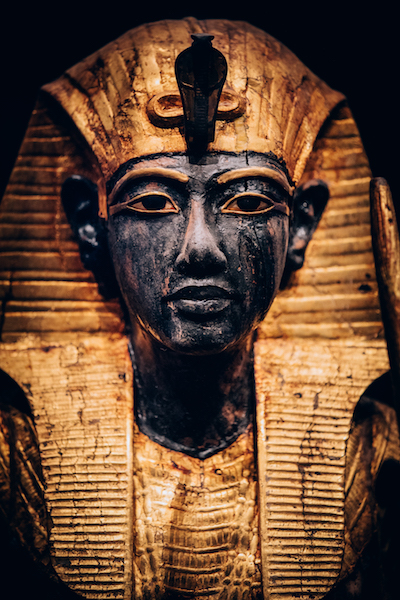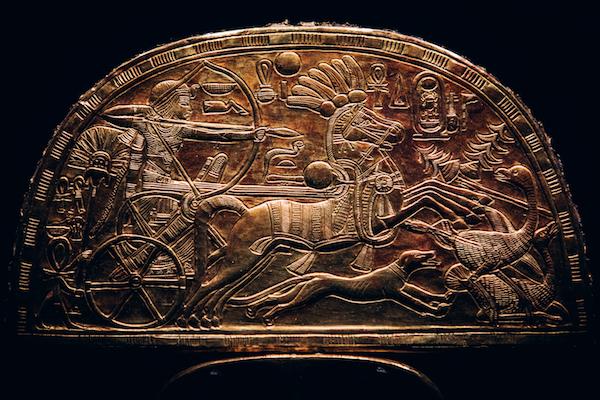In 1922 Hussein Abdel-Rassoul, a water boy with Howard Carter’s archaeological dig in the Valley of the Kings, accidentally uncovered a step in the sand. It proved to be the breakthrough for which Carter, on the hunt for the final resting place of King Tutankhamun, was looking. The tomb they uncovered showed signs of having been robbed in ancient times but inside thousands of items remained, selected for a journey to the afterlife, which had lain undisturbed for millennia. The survival of some was almost inconceivable: wooden boxes, linen gloves, unguents and cases packed with food. Others were more conventionally breathtaking: amulets, statues, jewellery and gold, gold, gold. It was, indeed, the tomb of king Tutankhamun who died aged 19 in 1325 BCE – and it was magnificent.
Magnificence is the entire premise of the show at the Saatchi. Before entering, visitors must first watch a stirring film conflating Tutankhamun’s life with the archaeological dig projected on a wraparound screen that stretches even cinemascope’s capacious proportions. The show itself comprises of six low-lit rooms accompanied by an orientalish soundtrack emitted by hidden speakers. The corridors in between are festooned with heavy dark drapes. An already cinematic experience becomes akin to immersive theatre. Texts are light on information and heavy on adornment. For much of the show the myth of the king – who was considered a deity in Ancient Egypt – is given precedence over the historical figure.
 Despite the splendour, the show doesn’t feel like it’s been staged with people in mind. Rooms are uncomfortably full and tickets are very expensive. Nor, it seems, has the Grand Egyptian Museum, which will be the final destination of the artefacts once they complete their 10-city show tour (London is city number three, after Los Angeles and Paris). The museum, which was conceived under Hosni Mubarak, has – according to Minister of Antiquities Khaled al-Anany – already cost over $1 billion, in large part through loans from Japan. It will be delivered six years behind schedule but, it is hoped, will provide a much-needed boost to the country’s tourism industry, which has been ailing since the 2011 uprising. The hope that a fancy new museum will be a quick fix for the country's problems is a delusion. The fact that the demolition of nearby informal housing sparked protests is a sharp reminder that Egypt’s problems run far deeper than international visitor numbers.
Despite the splendour, the show doesn’t feel like it’s been staged with people in mind. Rooms are uncomfortably full and tickets are very expensive. Nor, it seems, has the Grand Egyptian Museum, which will be the final destination of the artefacts once they complete their 10-city show tour (London is city number three, after Los Angeles and Paris). The museum, which was conceived under Hosni Mubarak, has – according to Minister of Antiquities Khaled al-Anany – already cost over $1 billion, in large part through loans from Japan. It will be delivered six years behind schedule but, it is hoped, will provide a much-needed boost to the country’s tourism industry, which has been ailing since the 2011 uprising. The hope that a fancy new museum will be a quick fix for the country's problems is a delusion. The fact that the demolition of nearby informal housing sparked protests is a sharp reminder that Egypt’s problems run far deeper than international visitor numbers.
Somewhat ironically then, a highlight here are the shabtis. These small models of ordinary workers were entombed with Tutankhamun so that they could serve the king in the afterlife. A large number were found – 413 to be precise. Made variously of wood, quartzite, alabaster and granite, each has distinct features and bears signs – which might be a flail, a hoe or a war crown – indicating how they would assist the king. Whatever the task, they must serve their master. Chapter 6 of the Egyptian Book of the Dead instructs shabtis on the unequivocal nature of their role. If, in the underworld, a shabti is called upon to do “any work that is done there”, whatever its nature they must step forward, saying “I am doing it! See I am here!”.
Nevertheless, I lingered in front of a fan holder, imagining how the ostrich hunt engraved into the gold unfolded over the course of the chase. I appreciated Tutankhamun’s teenage enjoyment of hunting birds with boomerangs and hippos from wake boards. Scenes depicting Tutankhamun and his wife, who was also his half-sister, Ankhesenamun, held my attention for their intimacy and their balanced treatment of personal affairs and royal duties. How would it have felt to have been treated as deities? Were the royal couple ever properly alone?
The final rooms focus on the history of the dig. A photograph of Hussein Abdel-Rassoul taken by Harry Burton touchingly depicts him wearing a pectoral that had been recovered. By eliding past and present, it allows us to imagine the boy who was king. He’s about the age of Tutankhamun when he ascended the throne and he looks both daunted and determined. It does what the rest of the show cannot do, which is to see the human behind the mask.
- Tutankhamun: Treasures of the Golden Pharaoh is at the Saatchi Gallery until 3 May 2020
- Read more visual arts reviews on theartsdesk










![SEX MONEY RACE RELIGION [2016] by Gilbert and George. Installation shot of Gilbert & George 21ST CENTURY PICTURES Hayward Gallery](/sites/default/files/styles/thumbnail_125_x_125_/public/mastimages/Gilbert%20%26%20George_%2021ST%20CENTURY%20PICTURES.%20SEX%20MONEY%20RACE%20RELIGION%20%5B2016%5D.%20Photo_%20Mark%20Blower.%20Courtesy%20of%20the%20Gilbert%20%26%20George%20and%20the%20Hayward%20Gallery._0.jpg?itok=3oW-Y84i)




Add comment